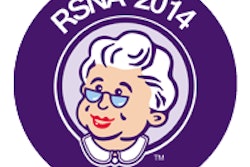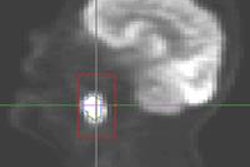By characterizing non-small cell lung cancer (NSCLC) tumors through glycolytic activity and FDG-PET volume after stereotactic body radiation therapy (SBRT), clinicians may be able to detect which tumors are likely to recur, according to a study presented at the American Society for Radiation Oncology (ASTRO) meeting.
If these tumors are identified, earlier and more effective treatment can be crafted for the benefit of these patients, researchers from Oakland University William Beaumont School of Medicine concluded.
"For tumors that have a high propensity for recurrence, we may follow them more quickly and offer treatment at an earlier time point," said lead author Dr. Ben Wilkinson, who presented the study results at ASTRO.
In the study, 164 patients with lung cancer were treated with SBRT and followed for at least one year to track local recurrence of tumors. In general, patients received four doses of 12 Gy for tumors 3 cm or smaller and five doses of 12 Gy for tumors larger than 3 cm.
Local recurrence
"Our definition of local recurrence was primarily clinical, based on evaluation by the clinician, biopsy when available, and CT and PET," Wilkinson said. Volumetric PET data were gathered using software with a gradient tool to account for all local recurrence of tumors.
For comparison, volumetric PET data were measured for a matched population for nonlocal recurrent tumors, based on tumor size, histology, and initial maximum standardized uptake values (SUVmax).
Glycolytic activity was calculated based on PET volume multiplied by mean SUV. Previous studies have found that in adults, tumors with high glucose activity are good candidates for evaluation with FDG-based PET. Glycolytic activity was recorded for all local recurrent tumors and matched with nonlocal recurrent tumors at baseline, six weeks, three months, six months, and 12 months after SBRT.
Median follow-up time for the 164 subjects was 1.7 years, ranging from one to 6.1 years, and median tumor size was 2.6 cm. Mean glycolytic tumor volume was 15.9 cc, ranging from 0.7 to 127.4 cc, and mean SUVmax was 8.6, ranging from 1.0 to 32.1.
Tumor detection
The researchers identified a total of 15 local recurrences (8.6%), 13 of which were in-field recurrent tumors (86%). Two patients had more than one local recurrent tumor. "The method of detection was primarily clinical diagnosis and biopsy, which confirmed local recurrence in 40% of the patients," Wilkinson added.
There were 26 nonlocal recurrence tumors, which were matched to the local recurrence cohort for comparison of glycolytic activity and PET volume over the study's follow-up time period. Volumetric assessment of FDG-PET avidity at the five potential time points was performed for a total of 41 tumors.
Following SBRT, glycolytic activity and PET volume changed at different rates for local recurrence compared to nonlocal recurrence, according to the researchers.
At three months after treatment, the mean glycolytic activity was 168.7 SUV/cc less than baseline for nonlocal recurrence, compared with 36.7 SUV/cc greater than baseline for tumors that would eventually recur. Similarly, PET volume decreased for nonlocal recurrence tumors (-14.9 cc), compared with an increase in PET volume for local recurrence tumors (+14.2 cc).
Volume change at other time points was not statistically different between local recurrence and nonlocal recurrence, Wilkinson and colleagues found.
Although a similar proportion of local and nonlocal recurrence patients received 48 Gy and 60 Gy, the researchers found a trend toward decreased total dose per centimeter of maximum tumor dimension.
Rare local recurrence
Based on the results, the researchers concluded that local recurrence after SBRT is rare, and the changes in glycolytic activity and PET volume from baseline are statistically different three months after treatment for locally recurrent tumors compared to nonlocally recurrent lung tumors.
"By measuring tumor kinetics of PET volume and glycolytic activity, it may allow us to select tumors with a high probability that recurrence may occur," Wilkinson said. "For tumors that have a high propensity for recurrence, we may follow them more quickly and offer treatment at an earlier time point. In the same way, tumors that decrease in their mass and PET volume, potentially, they may not need as rigorous follow-up."
The bottom line, he said, is that the change in treatment strategy could decrease costs.
These results and radiation dose per tumor warrant additional study to determine their role in the management of early-stage non-small cell lung cancer, the group concluded.



















